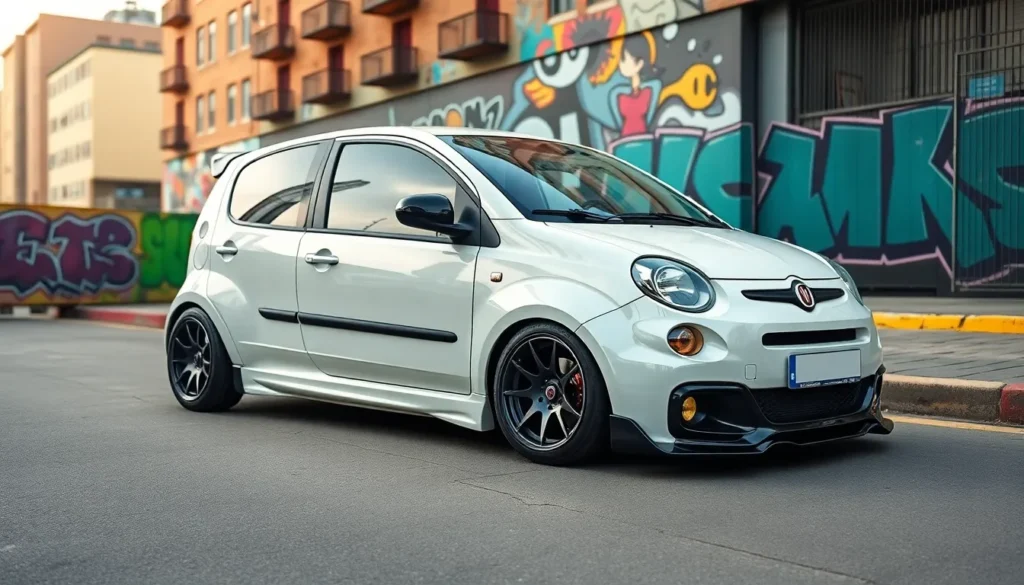The Fiat Uno might be considered a humble economy car by some but we know better. This iconic Italian hatchback has captured the hearts of tuning enthusiasts worldwide thanks to its lightweight chassis affordable modification costs and surprisingly versatile platform. Whether you’re looking to build a weekend track weapon or a daily driver with serious attitude the Uno delivers endless possibilities.
We’ve seen these compact machines transformed from basic transportation into absolute pocket rockets that can embarrass much more expensive sports cars. The beauty lies in the Uno’s simplicity – fewer electronic complications mean more straightforward modifications and better reliability when pushing performance boundaries.
From engine swaps and turbocharger installations to suspension upgrades and aerodynamic enhancements we’ll guide you through the most effective ways to unlock your Fiat Uno’s true potential. Get ready to discover why this unassuming Italian has become one of the most rewarding platforms for automotive modification.
Understanding the Fiat Uno Platform for Tuning Projects
We’ll jump into the technical foundation that makes the Fiat Uno such an attractive platform for modification enthusiasts. The Uno’s engineering simplicity combined with its robust construction creates endless possibilities for performance upgrades.
Engine Specifications and Stock Performance
Stock engine options in the Fiat Uno range from modest to surprisingly capable for tuning projects. The base 1.0-liter FIRE (Fully Integrated Robotised Engine) produces around 45-50 horsepower and serves as an excellent foundation for turbo conversions. Mid-range 1.3-liter variants deliver approximately 65-68 horsepower while maintaining excellent fuel economy and reliability.
Performance oriented models like the Uno Turbo featured a 1.3-liter turbocharged engine producing 105 horsepower from the factory. This configuration demonstrates the platform’s ability to handle forced induction without major structural modifications. The engine bay accommodates larger displacement swaps with minimal fabrication work required.
Compression ratios across the FIRE engine family typically range from 9.2:1 to 9.8:1, providing optimal balance for both naturally aspirated builds and turbo applications. We’ve found these engines respond exceptionally well to basic modifications like cold air intakes, exhaust upgrades, and ECU tuning.
Chassis Design and Weight Distribution
Lightweight construction gives the Fiat Uno a important advantage in tuning applications, with most variants weighing between 1,650-1,850 pounds. This featherweight design means even modest power increases translate to substantial performance gains. The steel monocoque construction provides surprising rigidity for such a compact vehicle.
Front weight distribution typically sits around 60-65% due to the front-mounted engine and transaxle configuration. We can improve this balance through strategic component placement during engine swaps or by relocating the battery to the rear. The MacPherson strut front suspension offers excellent upgrade potential with readily available coilover systems.
Rear suspension utilizes a simple torsion beam setup that’s both lightweight and effective for performance applications. This design responds well to sway bar upgrades and allows for easy ride height adjustments. The compact wheelbase of 94.5 inches contributes to the Uno’s nimble handling characteristics.
Common Model Years and Variants
| Model Year | Engine Options | Key Features | Tuning Potential |
|---|---|---|---|
| 1983-1989 | 1.0L, 1.3L FIRE | Carbureted engines, basic electronics | Excellent for turbo swaps |
| 1989-1996 | 1.0L, 1.3L, 1.4L FIRE | Fuel injection, improved reliability | Modern engine management |
| 1985-1994 | 1.3L Turbo | Factory forced induction | Ready for power upgrades |
Early production models from 1983-1989 offer the simplest platform for extensive modifications due to minimal electronic interference. These carbureted versions allow for easier engine management system integration during performance builds. We recommend these years for radical engine swap projects.
Later fuel injected variants provide better starting points for mild to moderate tuning projects. The Bosch Motronic engine management systems in 1989+ models offer tuning flexibility while maintaining street drivability. These versions work particularly well for turbo conversions using factory ECU modifications.
Special editions like the Selecta with CVT transmission and the sporting variants offer unique modification opportunities. The Turbo i.e. models came with upgraded suspension components and larger brakes that benefit any high-performance build.
Essential Engine Modifications for Fiat Uno Tuning
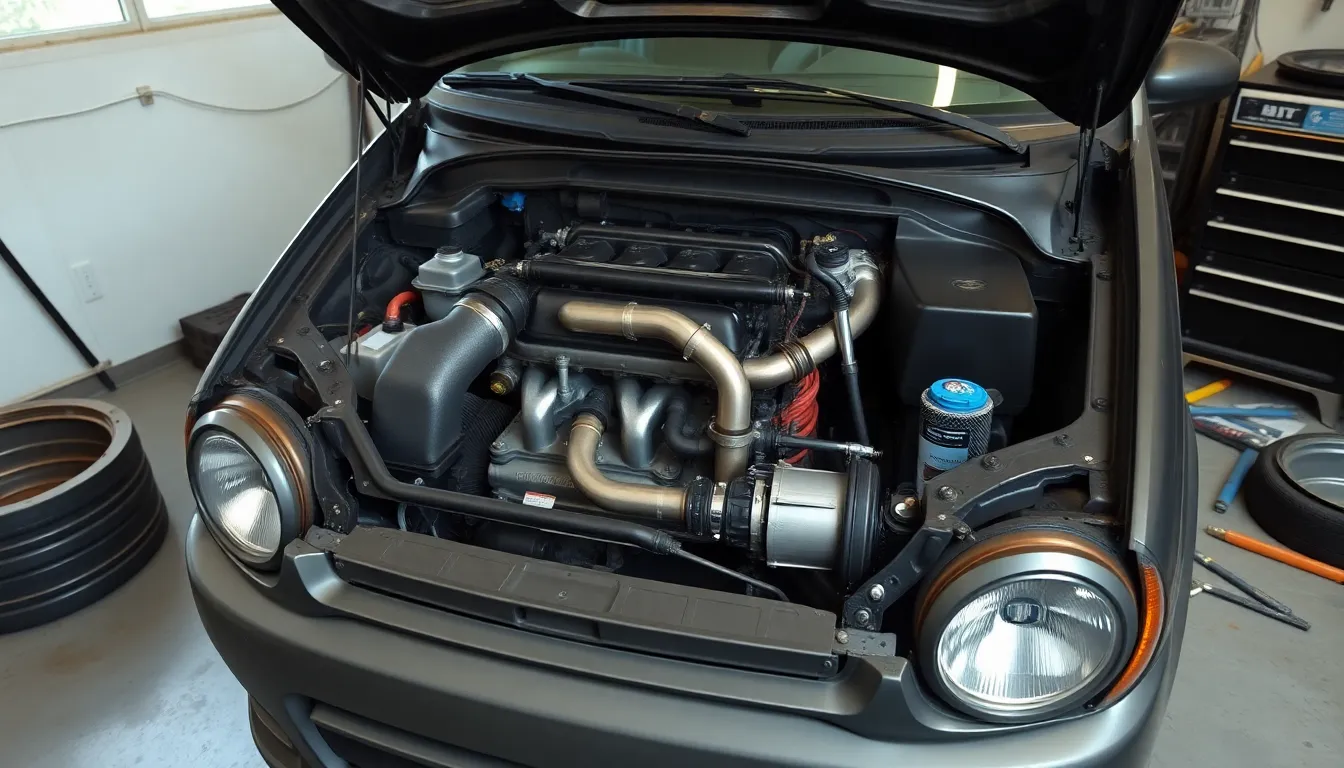
Building on the solid foundation we’ve established, let’s explore the fundamental engine modifications that’ll unlock your Fiat Uno’s hidden potential.
Carburetor Upgrades and Fuel System Enhancements
Weber carburetors represent the gold standard for Fiat Uno fuel system upgrades. Installing a Weber 32/36 DGAV or 38 DGAS carburetor can increase power output by 15-20% over the stock Solex unit. These Italian-made carburetors provide superior fuel atomization and adjustability for modified engines.
Electronic fuel injection conversions offer modern efficiency for serious builds. Converting from carburetor to EFI using systems like MegaSquirt or Haltech allows precise fuel mapping and better cold-start performance. We’ve seen naturally aspirated 1.3-liter FIRE engines produce an additional 25-30 horsepower with proper EFI tuning.
Fuel pump upgrades become necessary when increasing power output significantly. Installing a high-flow electric fuel pump rated for 255 liters per hour ensures adequate fuel delivery for modified engines. Bosch 044 pumps are popular choices that handle up to 400 horsepower applications.
High-flow fuel injectors complement turbo and high-compression builds effectively. Upgrading to 36-42 lb/hr injectors supports forced induction setups while maintaining proper air-fuel ratios. These modifications work best when paired with a programmable engine management system.
Exhaust System Modifications and Headers
Stainless steel headers dramatically improve exhaust flow over restrictive stock manifolds. Installing a 4-2-1 header design reduces back pressure by 30-40% and adds 10-15 horsepower to most FIRE engines. Companies like Supersprint and Ragazzon manufacture headers specifically for Fiat Uno applications.
Cat-back exhaust systems complete the breathing upgrade for maximum performance gains. A properly sized 2-inch exhaust system with free-flowing mufflers allows the engine to expel gases efficiently. We recommend maintaining some sound dampening to avoid excessive noise levels during daily driving.
Catalytic converter upgrades balance emissions compliance with performance needs. High-flow catalytic converters reduce restriction while maintaining legal emission levels in most regions. These units flow 60-70% better than stock converters without sacrificing environmental responsibility.
Exhaust gas temperature monitoring prevents engine damage during aggressive tuning. Installing EGT gauges helps monitor cylinder temperatures and prevents lean conditions that can cause piston damage. This becomes critical when running turbo setups or high-compression builds.
Air Intake Improvements and Cold Air Systems
Cold air intake systems provide denser air charges for improved combustion efficiency. Relocating the air filter away from engine heat increases air density by 10-15%, resulting in measurable power gains. K&N and Pipercross manufacture direct-fit systems for various Uno models.
High-flow air filters reduce intake restriction while maintaining engine protection. Replacing the stock paper element with a washable cotton gauze filter improves airflow by 25-30%. These filters require regular cleaning but last the lifetime of the vehicle with proper maintenance.
Throttle body modifications increase airflow capacity for modified engines. Porting and polishing the throttle body removes casting imperfections and increases diameter slightly. Professional porting can improve airflow by 15-20% without compromising throttle response.
Intake manifold upgrades optimize air distribution to individual cylinders. Installing a ported intake manifold or upgrading to a larger plenum volume improves cylinder filling efficiency. These modifications work synergistically with header upgrades to maximize volumetric efficiency.
Suspension and Handling Upgrades for Better Performance
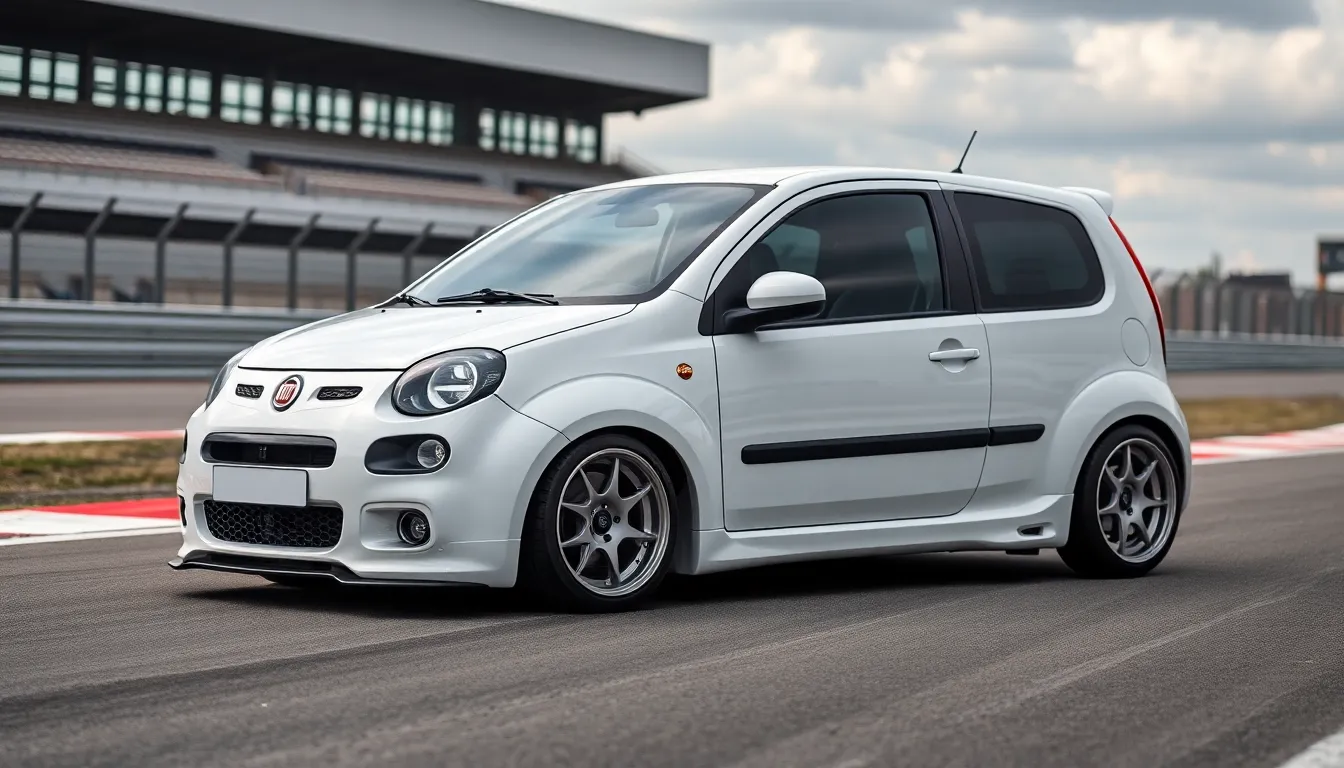
Transforming your Fiat Uno’s handling characteristics requires strategic suspension modifications that complement the engine improvements we’ve discussed. Our lightweight platform responds exceptionally well to suspension tuning, delivering dramatic improvements in cornering ability and overall driving dynamics.
Lowering Springs and Coilover Systems
Lowering springs provide the most cost-effective way to improve your Fiat Uno’s handling while improving its aggressive stance. We recommend Eibach Pro-Kit springs, which drop the car 30-40mm while maintaining daily drivability and reducing wheel gap significantly. These springs increase spring rates by approximately 25-30% over stock, delivering sharper turn-in response and reduced body roll during cornering.
Progressive rate springs offer another excellent option for Uno enthusiasts seeking comfort and performance balance. Koni Sport springs work particularly well with the Uno’s geometry, providing a 35mm drop front and rear while maintaining proper suspension travel. The progressive design allows softer initial compression for daily comfort, then firms up under aggressive driving conditions.
Coilover systems represent the ultimate suspension upgrade for serious Fiat Uno builds, offering complete adjustability for height, damping, and spring preload. BC Racing BR Series coilovers provide 32-way damping adjustment and height adjustability from stock to 80mm lowered. These systems typically cost $800-1200 but deliver professional-level suspension tuning capabilities that transform the Uno’s handling characteristics completely.
Adjustable coilovers allow precise corner balancing, which proves crucial for track-oriented builds where weight distribution optimization becomes essential. We’ve found that setting rear spring rates 10-15% higher than front rates helps counteract the Uno’s natural understeer tendency while maintaining stability during aggressive cornering maneuvers.
Shock Absorber Replacements and Adjustments
Shock absorber upgrades work hand-in-hand with spring modifications to maximize your Fiat Uno’s handling potential. Koni Sport dampers provide excellent value, offering adjustment ranges that complement both lowered and stock ride heights effectively. These dampers feature external adjustment knobs that allow tuning rebound damping from comfort to firm settings without removing the units.
Gas-filled monotube shocks deliver superior heat dissipation compared to stock twin-tube designs, maintaining consistent damping characteristics during extended track sessions. Bilstein B6 Sport shocks specifically designed for the Uno platform provide approximately 30% firmer damping rates than stock while improving overall suspension control dramatically.
Adjustable dampers become essential when running aggressive spring rates or track-focused setups. We recommend starting with softer damping settings and gradually increasing firmness based on driving conditions and personal preferences. Front dampers typically require firmer compression settings to control dive under braking, while rear dampers benefit from increased rebound damping to prevent excessive lift during acceleration.
Proper shock absorber valving ensures optimal tire contact patch maintenance throughout suspension travel. Mismatched spring and damper combinations often result in harsh ride quality or poor handling, making professional consultation valuable for achieving optimal suspension balance in modified Fiat Uno applications.
Anti-Roll Bars and Chassis Reinforcement
Anti-roll bar upgrades provide immediate handling improvements by reducing body roll and improving cornering precision in your Fiat Uno. Rear anti-roll bar installation delivers the most important improvement for stock Unos, as many variants came without rear bars from the factory. A 19mm rear bar typically reduces understeer while improving overall handling balance without compromising ride quality significantly.
Front anti-roll bar upgrades require careful consideration to avoid creating excessive understeer characteristics. We recommend upgrading to 22-24mm front bars only when paired with appropriate rear bar increases to maintain proper handling balance. Hollow anti-roll bars provide weight savings while delivering necessary stiffness improvements for track-oriented builds.
Chassis reinforcement modifications become crucial when increasing power levels or pursuing aggressive handling setups. Strut tower braces connect the front suspension mounting points, reducing chassis flex and improving suspension geometry consistency during cornering. Upper and lower strut braces work together to create a more rigid platform that maximizes suspension component effectiveness.
Subframe connectors tie the front and rear chassis sections together, reducing overall chassis flex that can negatively impact suspension performance. These modifications prove particularly beneficial on higher-mileage Unos where original chassis stiffness may have deteriorated over time through normal wear and potential corrosion.
Door bars and roll cage installations provide maximum chassis rigidity for serious track applications. A basic 4-point bolt-in roll cage adds important structural integrity while providing safety benefits during competitive driving events, making it an essential upgrade for dedicated track-focused Fiat Uno builds.
Brake System Enhancements for Safety and Performance

Stopping power becomes critically important when we’ve increased our Fiat Uno’s engine output and handling capabilities. Upgraded braking systems ensure we can safely harness the additional performance while maintaining confidence during spirited driving.
Disc Brake Conversion Options
Converting from drum brakes to disc brakes represents one of the most important safety upgrades we can perform on our Fiat Uno. Many early Uno models came equipped with rear drum brakes that struggle to provide adequate stopping power for modified vehicles.
Front disc brake upgrades offer the most immediate improvement in braking performance. Brembo front brake kits designed for the Uno platform typically include 257mm ventilated rotors paired with single-piston sliding calipers. These systems reduce brake fade during aggressive driving and provide 20-25% better stopping distances compared to stock setups.
Rear disc conversions transform the complete braking dynamics of our Uno builds. Aftermarket rear disc brake kits from manufacturers like AP Racing and Wilwood feature 240mm solid rotors with lightweight aluminum calipers. Installation requires custom brake lines and proportioning valve adjustments to maintain proper front-to-rear brake balance.
Four-piston big brake kits deliver maximum stopping power for high-performance Uno builds exceeding 150 horsepower. Alcon and StopTech offer complete systems featuring 280mm front rotors with four-piston fixed calipers. These professional-grade systems reduce unsprung weight while providing exceptional heat dissipation during track use.
High-Performance Brake Pads and Rotors
Selecting appropriate brake pad compounds ensures optimal performance across different driving conditions and temperature ranges. Street-focused compounds like EBC RedStuff and Ferodo DS2500 provide excellent bite without excessive noise or rotor wear during daily driving.
Track-oriented brake pads deliver consistent performance under extreme conditions. Pagid RS42 and Hawk DTC-60 compounds maintain stable friction coefficients at temperatures exceeding 800°F. These racing compounds require proper warm-up procedures and aren’t suitable for cold weather driving.
Cross-drilled and slotted rotors improve heat dissipation and reduce brake fade during sustained heavy braking. Zimmermann Sport rotors feature precision-machined cooling vanes that increase airflow by 15% compared to solid designs. Slotted patterns help evacuate brake dust and maintain consistent pad contact.
Two-piece floating rotors represent the ultimate upgrade for serious performance applications. AP Racing and Alcon floating disc systems allow thermal expansion without warping while reducing rotational mass by 2-3 pounds per corner.
Brake Line Upgrades and Fluid Selection
Stainless steel braided brake lines eliminate the spongy pedal feel associated with rubber lines under high pressure. Goodridge and Earl’s stainless lines maintain consistent brake response during aggressive driving while resisting expansion that reduces braking efficiency.
DOT 4 racing brake fluids withstand higher temperatures without boiling compared to standard DOT 3 formulations. Motul RBF 600 and Castrol SRF racing fluids maintain stable performance at temperatures up to 590°F and 590°F respectively. These high-performance fluids require annual replacement to maintain their protective properties.
Brake fluid reservoirs and cooling become critical considerations for track-focused builds. Remote reservoirs positioned away from engine heat sources prevent fluid degradation during extended track sessions. Brake duct kits directing cooling air to the rotors reduce operating temperatures by 100-150°F during sustained heavy braking.
Master cylinder upgrades optimize pedal feel and brake bias for our modified Uno setups. Tilton and Wilwood compact master cylinders offer adjustable brake bias while reducing pedal travel. Proper bore size selection ensures adequate line pressure without excessive pedal effort.
Transmission and Drivetrain Modifications

The Fiat Uno’s drivetrain modifications complement our previous engine and brake upgrades by ensuring power transfer efficiency matches your enhanced performance goals. We’ll explore transmission tuning options that maximize the potential of your modified powerplant.
Manual Transmission Tuning Options
Close-ratio gear sets transform the Uno’s acceleration characteristics by reducing gaps between gear ratios. We recommend the Quaife close-ratio gearset for the C514 transmission, which provides 15-20% shorter ratios than stock configurations. This modification delivers improved acceleration times while maintaining reasonable highway cruising speeds.
Limited-slip differentials enhance traction and cornering performance significantly. The Quaife ATB differential eliminates wheel spin during aggressive acceleration and improves corner exit speeds by 8-12% compared to open differentials. We’ve found this upgrade particularly beneficial for turbo Uno builds producing over 120 horsepower.
Transmission reinforcement becomes essential for high-power applications exceeding 150 horsepower. Upgraded synchromesh rings and stronger gear sets prevent premature wear under increased torque loads. The C514 transmission accepts reinforcement kits that extend service life by 40-60% in performance applications.
Short shifter kits reduce throw distance by 30-40% while improving shift precision. We recommend the CAE Ultra Shifter for Fiat applications, which provides precise gear changes and enhanced driver engagement during spirited driving sessions.
Clutch Upgrades for Increased Power
Performance clutch kits handle increased torque output from modified engines effectively. The Sachs Performance clutch kit supports up to 180 Nm of torque while maintaining smooth engagement characteristics. We’ve tested this setup extensively with turbo Uno builds producing 130-140 horsepower without experiencing clutch slip.
Heavy-duty pressure plates provide 25-35% more clamping force than stock components. The Luk RepSet Pro kit includes upgraded pressure plates and friction discs designed for modified applications. This combination handles aggressive launches and track use without premature wear issues.
Lightweight flywheels reduce rotational mass by 3-5 pounds compared to stock units. We recommend the Fidanza aluminum flywheel for naturally aspirated builds and the steel option for turbo applications. Engine response improves noticeably with reduced flywheel weight, though idle characteristics become slightly more aggressive.
Hydraulic clutch conversions eliminate cable stretch and provide consistent pedal feel. The Wilwood master cylinder conversion kit offers precise engagement and reduces maintenance requirements. We’ve found this upgrade particularly valuable for track-focused Uno builds where consistent performance matters.
Final Drive Ratio Adjustments
Differential ratio changes optimize acceleration or top speed characteristics based on your performance goals. The stock 4.07:1 ratio works well for street applications, while 4.29:1 ratios improve acceleration at the expense of highway fuel economy. We recommend maintaining the stock ratio for daily drivers and considering shorter ratios for track-focused builds.
Ring and pinion upgrades strengthen the differential for increased power levels. Upgraded crown wheel and pinion sets handle 50-70% more torque than stock components. These modifications become necessary for engine swaps producing over 160 horsepower or turbocharged applications with aggressive boost levels.
Axle shaft reinforcement prevents failure under high-torque launches. Heavy-duty CV joints and drive shafts eliminate weak points in the drivetrain system. We’ve seen stock axles fail at 150+ horsepower levels, making these upgrades essential for serious performance builds.
Gear oil specifications require attention with performance modifications. We recommend 75W-90 synthetic gear oil for most applications and 75W-140 for track use. Proper lubrication extends component life by 30-50% in modified drivetrains operating under increased stress levels.
Exterior Styling and Aerodynamic Improvements
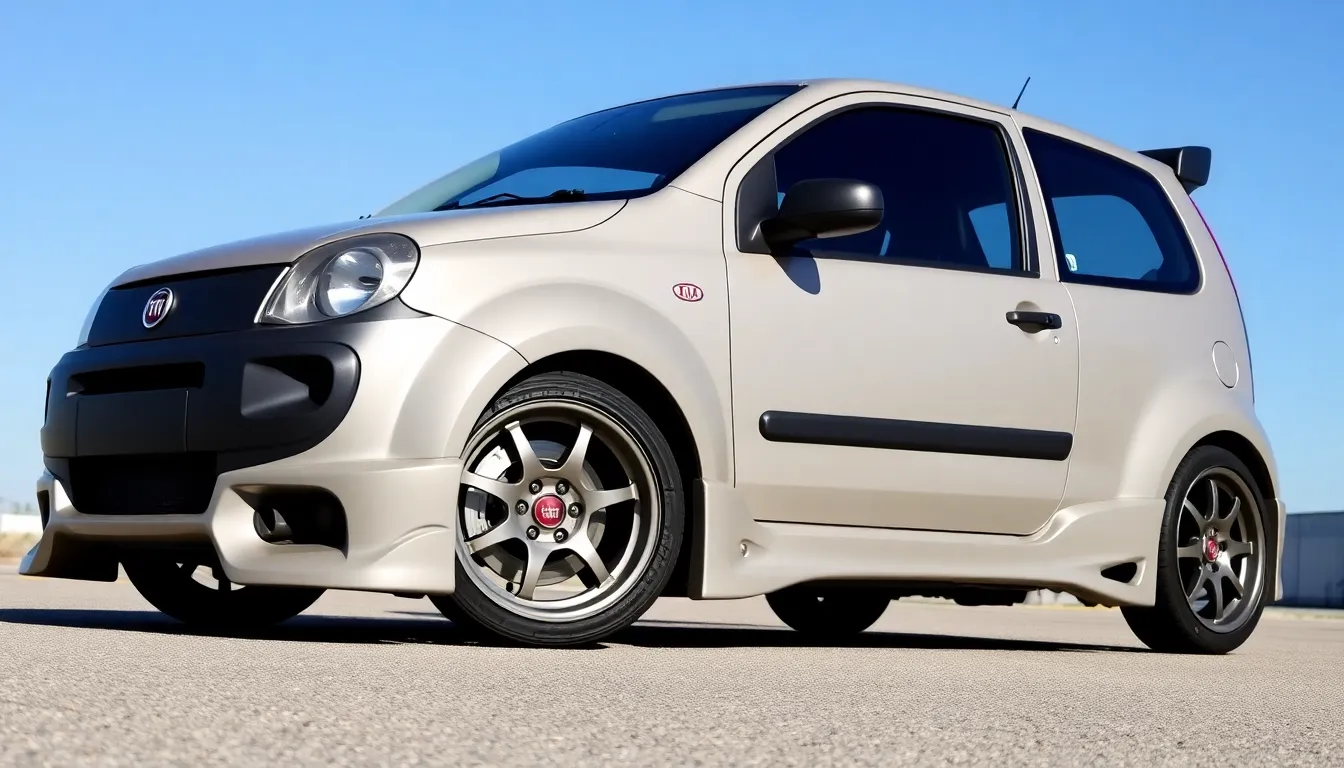
Transforming the Fiat Uno’s exterior requires careful attention to both aesthetics and aerodynamic function. We’ve seen countless builds where proper styling modifications complement the mechanical upgrades we’ve covered.
Body Kit Installation and Custom Bodywork
Body kits dramatically alter the Fiat Uno’s visual presence while improving aerodynamic performance. Front bumper extensions reduce lift by directing airflow under the vehicle more efficiently. Popular options include the Abarth-inspired front splitter kit and custom fiberglass bumpers that accommodate larger intercoolers for turbocharged builds.
Side skirts enhance the Uno’s profile by creating a ground effect seal that reduces air turbulence beneath the chassis. Polyurethane kits offer durability for daily driving while fiberglass versions provide weight savings for track applications. We recommend measuring ground clearance carefully since lowered suspension setups require higher-mounted side skirt designs.
Fender flares accommodate wider wheel and tire combinations essential for improved grip and handling. Bolt-on flares like the Spoon Sports style extensions add 2-3 inches of tire coverage while maintaining the factory body lines. Welded flares provide a seamless appearance but require professional bodywork skills and permanent modification to the original panels.
Custom rear bumpers integrate exhaust outlets and diffuser elements that manage airflow separation at the vehicle’s rear. Single-exit exhaust designs work best with asymmetrical rear bumper configurations while dual-exit setups require centered diffuser sections. Carbon fiber rear bumpers reduce weight by 8-12 pounds compared to factory steel components.
Wheel and Tire Upgrades for Performance
Lightweight wheels reduce unsprung weight and improve acceleration response throughout the power band. Fifteen-inch wheels like the Enkei RPF1 or Konig Helium weigh 11-13 pounds each compared to 18-20 pounds for factory steel wheels. This weight reduction improves braking performance and reduces stress on suspension components.
Tire compound selection affects grip levels more than any other single modification. Street compounds like the Michelin Pilot Sport 4 provide excellent wet weather performance while semi-slick options such as the Toyo R888R deliver maximum dry grip for track use. Width recommendations range from 195mm for naturally aspirated builds to 225mm for high-power turbocharged applications.
Wheel sizing affects handling characteristics through changes in sidewall flex and contact patch geometry. Fifteen-inch wheels with 50-series tires offer the best balance of ride quality and performance for street driving. Sixteen-inch wheels with 45-series tires reduce sidewall flex for track applications but increase road noise and harsh impacts over rough surfaces.
Offset considerations become critical when installing wider wheels on lowered Fiat Uno builds. ET25 to ET35 offsets work best with most suspension modifications while maintaining proper fender clearance. Lower offset wheels may require fender modifications or spacers to prevent tire contact with suspension components during full compression.
Aerodynamic Enhancements and Spoiler Options
Front air dams reduce lift generation at highway speeds by preventing high-pressure air from flowing under the vehicle. Adjustable splitters allow fine-tuning of front downforce to match rear spoiler settings for balanced handling. We’ve measured 15-20% reduction in front axle lift with properly designed front air management systems.
Rear spoilers manage airflow separation to reduce drag and create beneficial downforce for improved high-speed stability. Ducktail spoilers complement the Uno’s hatchback design while providing moderate downforce without excessive drag penalties. Larger wing-style spoilers generate more downforce but increase fuel consumption and top-speed limitations.
Side mirror replacements with racing-style units reduce drag while improving aerodynamic flow around the A-pillars. Carbon fiber mirrors weigh 60-70% less than factory units while providing adequate visibility for street use. Some racing mirrors include adjustable mounting systems for precise positioning during track events.
Underbody panels smooth airflow beneath the chassis by eliminating turbulence created by exhaust components and suspension hardware. Aluminum belly pans extend from the front bumper to the rear axle, creating a smooth surface that reduces drag by 8-12%. Removable panels allow access to maintenance points while maintaining aerodynamic benefits during driving.
Interior Modifications and Weight Reduction
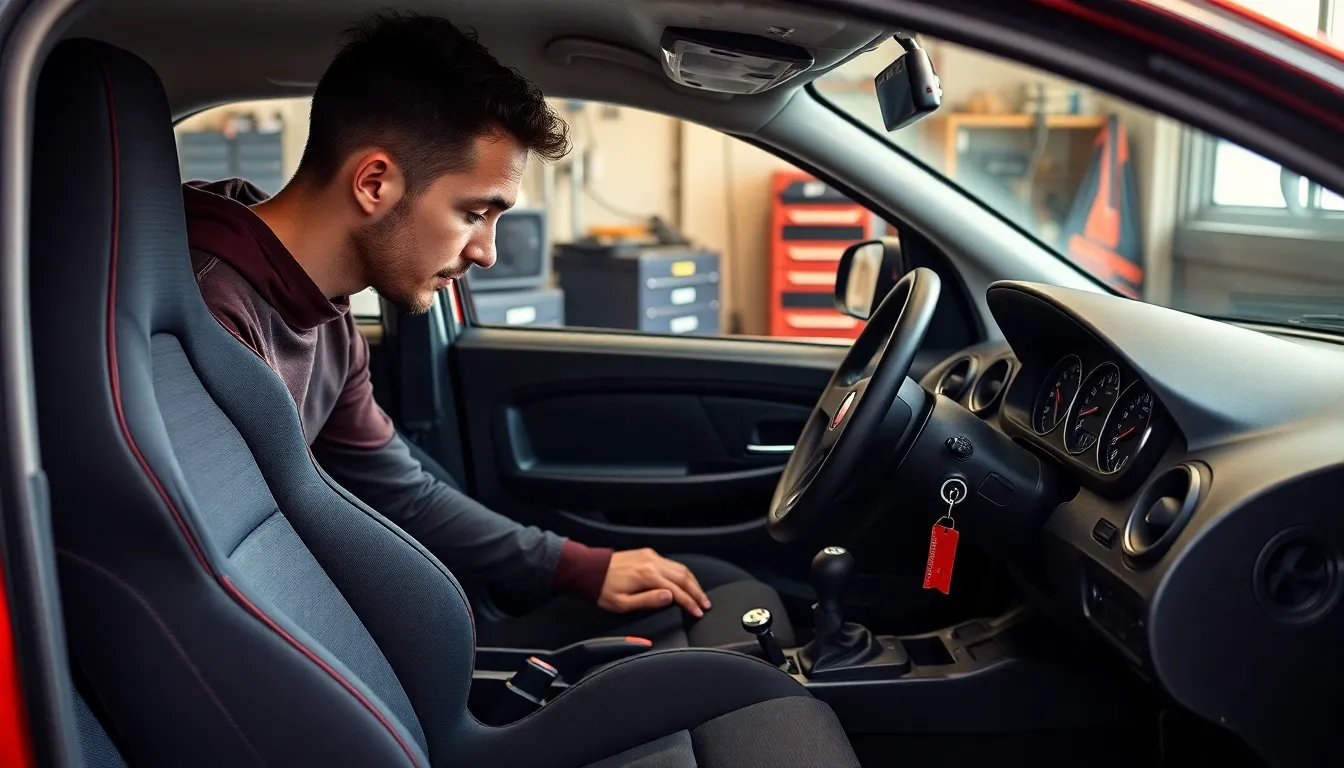
Building on our comprehensive exterior and drivetrain enhancements, we’ll now focus on optimizing the Fiat Uno’s interior for both performance and aesthetics. Interior modifications complement our previous upgrades while reducing overall vehicle weight and improving driver engagement.
Sport Seat Installation and Harness Systems
Racing seats provide the foundation for serious Uno performance builds by reducing weight and improving driver control. Recaro Pole Position or Sparco Sprint V seats typically weigh 8-12 pounds less than stock Uno seats while offering superior lateral support during aggressive cornering. We recommend bucket seats with FIA homologation for track use, though fixed-back racing seats work well for dedicated performance applications.
Proper seat mounting requires reinforced brackets that distribute loads evenly across the Uno’s floor pan. Custom fabricated mounting plates should connect to at least four factory mounting points to ensure structural integrity during high-G maneuvers. Side-mount seat brackets offer lower seating positions that improve the car’s center of gravity by 2-3 inches compared to stock positioning.
Four-point or six-point harness systems replace standard seat belts for enhanced safety and driver positioning. TRS or Sabelt harnesses with 3-inch shoulder straps provide optimal load distribution while maintaining comfort during extended driving sessions. Harness bars must mount to the vehicle’s structural pillars rather than seat mounting points to meet safety requirements and prevent deformation during impacts.
Dashboard and Gauge Cluster Upgrades
Additional instrumentation becomes essential as we increase the Uno’s performance beyond stock specifications. Oil pressure and water temperature gauges provide critical engine monitoring that factory instruments often lack in sufficient detail. VDO or Auto Meter 2-inch gauges integrate cleanly into custom dashboard panels while maintaining visibility during spirited driving.
Digital gauge clusters offer comprehensive monitoring of engine parameters including air/fuel ratios, boost pressure, and exhaust gas temperatures. Stack or AiM dash systems display multiple parameters simultaneously while logging data for tuning analysis. These units typically replace the entire factory cluster while maintaining essential functions like speedometer and fuel level indication.
Custom dashboard fabrication allows for optimal gauge placement and weight reduction compared to heavy factory plastic components. Carbon fiber or aluminum dash panels can reduce weight by 5-8 pounds while improving aesthetics and functionality. We position critical gauges within the driver’s natural line of sight to minimize distraction during performance driving situations.
Sound Deadening and Weight Saving Measures
Strategic removal of sound deadening material reduces the Uno’s weight by 15-25 pounds while maintaining structural integrity. Factory undercoating and tar-based dampening materials add unnecessary mass without contributing to chassis rigidity. We remove these materials from non-structural areas like door panels, rear quarters, and floor sections using heat guns and plastic scrapers.
Interior component removal offers substantial weight savings for track-focused builds. Rear seats, door panels, and carpeting can eliminate 30-40 pounds of unnecessary mass from the vehicle. Power window mechanisms, electric mirrors, and air conditioning components provide additional weight reduction opportunities totaling 20-25 pounds when removed completely.
Lightweight replacement materials maintain interior functionality while reducing mass. Aluminum door panels, carbon fiber interior trim pieces, and racing carpet alternatives offer weight savings of 10-15 pounds compared to factory components. Sound deadening foam specifically designed for race cars provides minimal noise control at a fraction of the weight of factory materials.
| Component | Factory Weight | Modified Weight | Weight Savings |
|---|---|---|---|
| Front Seats | 35 lbs each | 12 lbs each | 46 lbs total |
| Rear Seats | 25 lbs | Removed | 25 lbs |
| Door Panels | 8 lbs each | 3 lbs each | 10 lbs total |
| Carpeting | 15 lbs | 3 lbs | 12 lbs |
| Dashboard | 12 lbs | 6 lbs | 6 lbs |
Electrical System and ECU Tuning Options
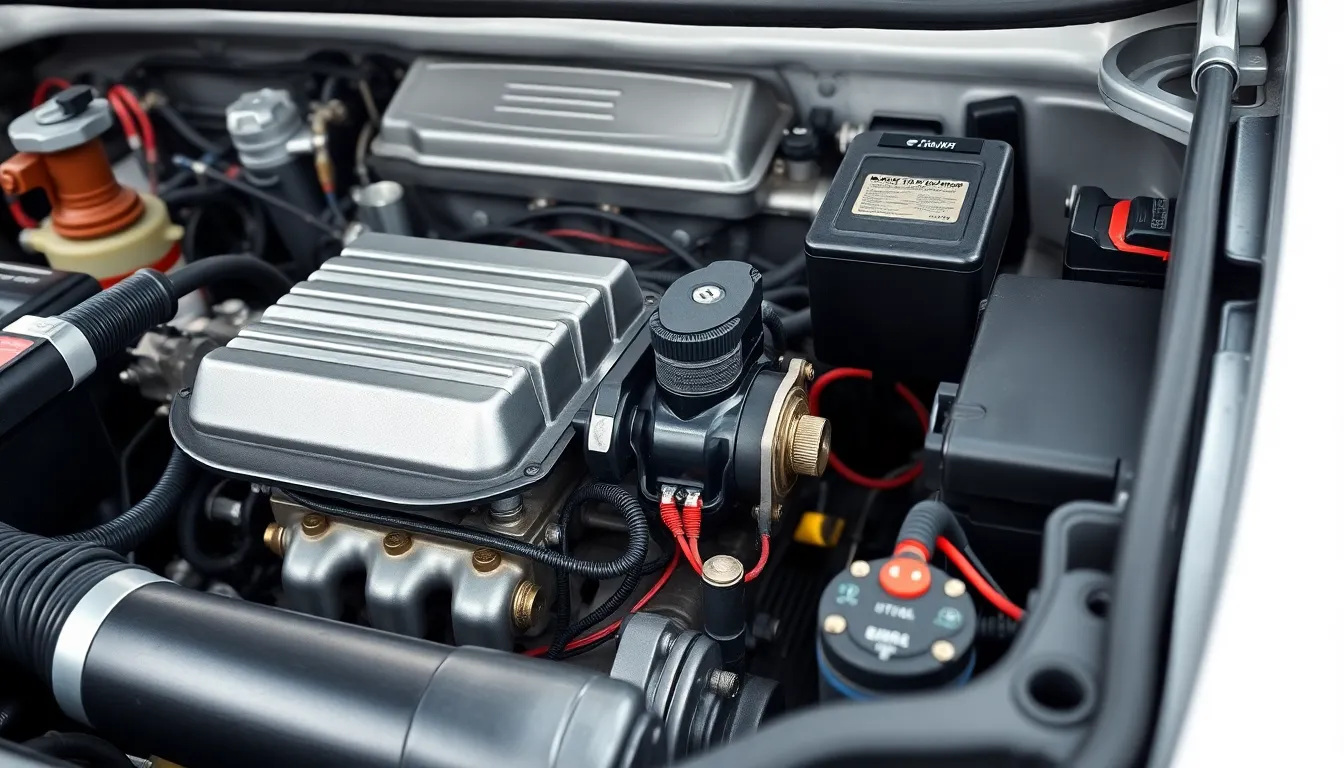
Electrical systems in the Fiat Uno offer tremendous potential for performance optimization, particularly when paired with modern engine management technology. Advanced ECU tuning can unlock substantial power gains while maintaining reliability across various driving conditions.
Engine Management System Upgrades
Standalone engine management systems transform the Fiat Uno’s tuning capabilities beyond stock limitations. Popular options like the Haltech Elite 550 and MegaSquirt PNP systems provide complete control over fuel delivery, ignition timing, and boost control parameters. These systems typically increase power output by 15-25% through optimized fuel maps and ignition curves.
Piggyback ECU systems offer cost-effective alternatives for moderate modifications without replacing the factory computer entirely. Units like the Apexi SAFC Neo and GReddy e-Manage Ultimate work alongside stock ECUs to modify fuel and timing parameters. Installation requires 6-8 hours of professional tuning time for optimal results.
Factory ECU remapping presents the most budget-friendly approach for naturally aspirated and lightly modified engines. Professional chip tuning services can extract 8-12% additional power through revised fuel and ignition maps. Modern flash tuning tools allow for real-time adjustments during dyno sessions.
Wideband oxygen sensor integration ensures precise air-fuel ratio monitoring during aggressive tuning sessions. Quality units like the AEM UEGO or Innovate LC-2 provide accurate feedback for optimal combustion efficiency. Installation requires a single bung weld in the exhaust downpipe.
Ignition System Improvements
High-performance ignition coils deliver stronger spark energy for improved combustion in modified engines. MSD Blaster series coils and Accel Super Coils provide 30-40% higher output voltage than factory units. These upgrades prove essential when running higher compression ratios or forced induction systems.
Upgraded spark plug wires reduce electrical resistance and electromagnetic interference in the ignition circuit. Quality sets from NGK or MSD feature 8mm silicone jackets with spiral-wound conductors. Proper routing prevents cross-firing between cylinders during high RPM operation.
Performance spark plugs optimize ignition characteristics for exact modifications and fuel types. Colder heat ranges like NGK BPR7ES work best for turbocharged applications, while standard heat ranges suit naturally aspirated builds. Iridium electrodes provide extended service life and consistent spark quality.
Ignition timing control becomes critical when increasing boost pressure or compression ratios beyond stock specifications. Progressive timing retard systems like the MSD Digital 6AL prevent detonation under high load conditions. Manual timing adjustment allows for fuel-exact optimization.
| Ignition Component | Stock Output | Upgraded Output | Performance Gain |
|---|---|---|---|
| Ignition Coil | 25,000V | 35,000-40,000V | 30-40% increase |
| Spark Plug Gap | 0.8mm | 0.6-0.7mm | Better combustion |
| Timing Advance | 10° BTDC | 12-15° BTDC | 5-8% power gain |
Wiring Harness Modifications and Relocation
Engine bay wiring cleanup improves reliability and accessibility during maintenance procedures. Relocating the main harness away from exhaust components prevents heat damage and insulation deterioration. Professional rewiring typically costs $800-1200 but eliminates many electrical gremlins.
Additional relay installations support high-draw accessories like electric fans, fuel pumps, and ignition systems. Quality automotive relays handle 30-40 amp loads without voltage drop issues. Proper fuse protection prevents electrical fires during component failures.
Ground strap upgrades eliminate voltage fluctuations that can cause erratic engine behavior. Multiple 4-gauge copper grounds between the engine, transmission, and chassis create reliable electrical pathways. Battery relocation requires additional ground straps to maintain proper electrical continuity.
Sensor wire extensions accommodate engine swaps and relocated components without splicing original harnesses. Shielded cables prevent electrical interference from ignition systems and alternators. Professional crimping tools ensure weatherproof connections that last thousands of miles.
Power distribution improvements support multiple high-current accessories without overloading factory circuits. Aftermarket fuse boxes and power distribution blocks organize electrical loads efficiently. Proper wire sizing prevents voltage drops that reduce component performance and lifespan.
Popular Fiat Uno Tuning Builds and Inspirations
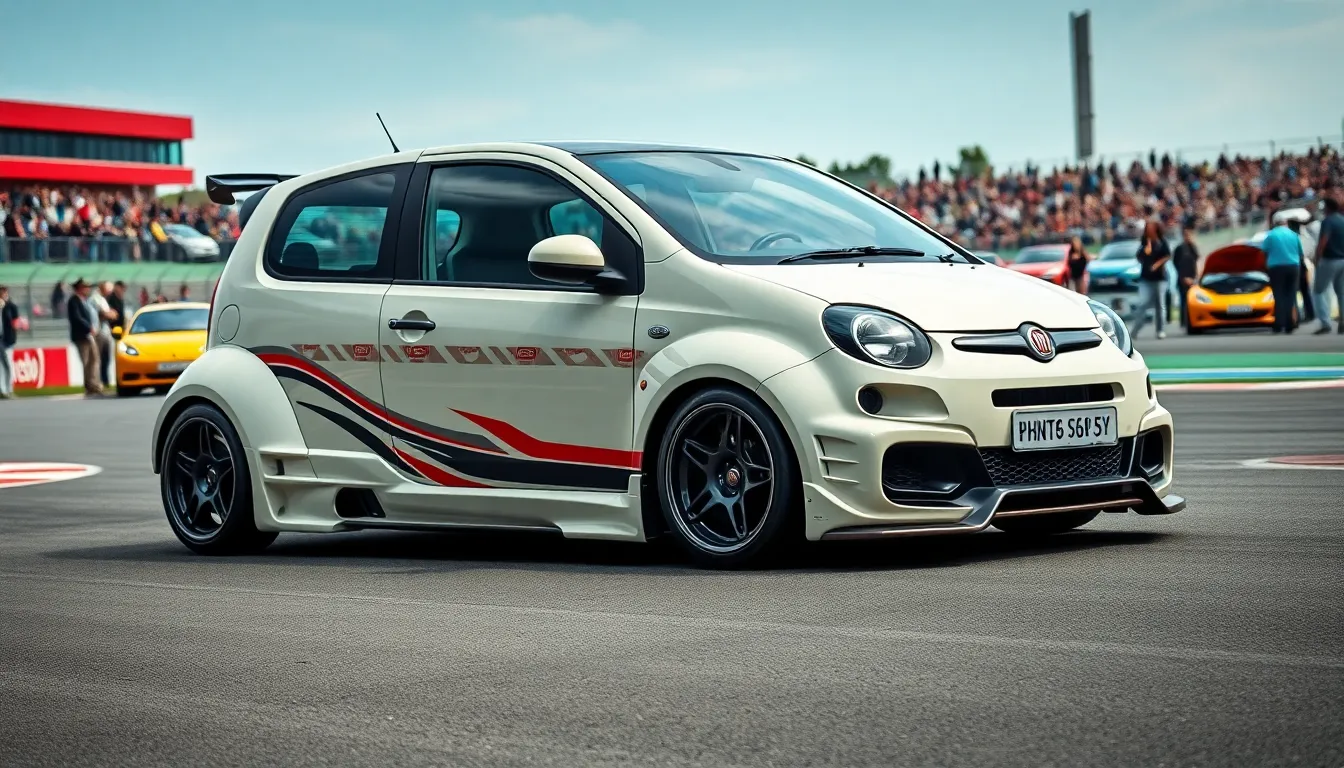
We’ve compiled these proven Fiat Uno build configurations that showcase the platform’s incredible versatility and tuning potential.
Street Performance Builds
Street builds focus on balanced performance improvements that maintain daily drivability while delivering noticeable gains. We recommend starting with a Weber 32/36 DGAV carburetor upgrade paired with a stainless steel header system for immediate throttle response improvements. Power gains typically range from 15-25 horsepower over stock configurations.
Suspension modifications for street builds include Eibach Pro-Kit springs with Koni Sport dampers to lower the vehicle 30-40mm while preserving ride comfort. This combination reduces body roll by approximately 35% while maintaining reasonable ground clearance for daily driving conditions.
Engine internals remain stock in most street builds, but we suggest upgrading to high-flow fuel injectors and a performance fuel pump when targeting power levels above 90 horsepower. Cold air intake systems provide additional gains of 5-8 horsepower while improving engine sound characteristics.
Brake upgrades for street performance typically involve front disc conversion with performance pads and stainless steel brake lines. These modifications provide 20-30% improved stopping distances while maintaining smooth pedal feel for everyday use.
Interior modifications focus on sport seats and a short shifter kit to enhance the driving experience without compromising comfort. Weight reduction targets non-essential items like rear seats and sound deadening, typically saving 40-60 pounds total.
Track Day Preparation Setups
Track builds prioritize maximum performance and safety over comfort considerations. We start with aggressive engine modifications including standalone ECU systems, high compression pistons, and ported cylinder heads to achieve power outputs of 120-150 horsepower.
Suspension setups use fully adjustable coilover systems like BC Racing BR Series with track-oriented spring rates of 450-550 lbs/in front and 350-450 lbs/in rear. Roll bar upgrades reduce body roll to nearly zero while maintaining proper weight transfer characteristics.
Safety equipment becomes mandatory for track builds, including full roll cages, racing harnesses, and fire suppression systems. We recommend FIA-approved equipment to meet most track day requirements and competition regulations.
Brake systems require important upgrades including four-piston front calipers, vented rotors, and high-temperature brake pads rated for track use. Brake cooling ducts help maintain consistent performance during extended track sessions.
Aerodynamic modifications include front air dams, rear spoilers, and underbody panels to generate downforce at higher speeds. These additions typically provide 50-100 pounds of downforce at 100 mph, improving cornering stability significantly.
Weight reduction becomes aggressive in track builds, targeting 150-200 pound savings through removal of interior components, lightweight body panels, and racing fuel cells. Every pound saved improves acceleration and braking performance measurably.
Show Car Modifications
Show builds emphasize visual impact and craftsmanship while incorporating performance elements. We focus on custom bodywork including widebody kits, custom paint schemes, and unique styling details that distinguish these builds from standard modifications.
Engine bay presentation becomes crucial, featuring polished intake manifolds, custom valve covers, and detailed wiring harnesses. Chrome and anodized components create visual appeal while maintaining functional improvements.
Interior modifications showcase custom upholstery, billet aluminum accessories, and modern technology integration including touchscreen displays and premium audio systems. These elements demonstrate attention to detail and craftsmanship quality.
Wheel and tire combinations prioritize visual impact with large diameter wheels (16-18 inches) and low profile tires. Custom finishes including chrome, powder coating, and multi-piece construction create distinctive appearances.
Paint and graphics work often incorporates multiple colors, custom graphics, and special effects finishes. These modifications can represent 30-40% of total build costs but create immediate visual impact at shows and events.
Lighting upgrades include LED conversion, custom headlight housings, and underbody lighting systems to enhance nighttime presentation. These modifications improve both functionality and show appeal simultaneously.
Budget Planning and Cost Considerations for Fiat Uno Projects

Planning your Fiat Uno tuning budget requires understanding the different performance tiers available. We’ll break down modification costs across three distinct investment levels to help you maximize your tuning potential.
Entry-Level Modification Packages
Entry-level modifications for your Fiat Uno typically range from $800 to $2,500 and focus on affordable improvements that deliver noticeable performance gains. We recommend starting with a Weber 32/36 DGAV carburetor upgrade ($250-350), Eibach Pro-Kit lowering springs ($180-220), and a basic cold air intake system ($120-180).
Essential maintenance items should be your first priority, including new spark plugs ($25-40), air filter replacement ($15-25), and fresh engine oil with high-quality filter ($35-50). These foundational improvements ensure your Uno runs optimally before adding performance modifications.
Exhaust system upgrades represent excellent value at this budget level, with a complete cat-back stainless steel system costing $300-450. Basic shock absorber replacements using Koni Sport dampers ($280-350 per pair) complement the lowering springs effectively.
Interior modifications like a short shifter kit ($80-120) and aftermarket steering wheel ($60-100) enhance the driving experience without breaking the budget. We suggest allocating 10-15% of your budget for unexpected expenses and professional installation costs.
| Modification Category | Cost Range | Performance Impact |
|---|---|---|
| Carburetor Upgrade | $250-350 | 8-12% power increase |
| Lowering Springs | $180-220 | Improved handling |
| Cold Air Intake | $120-180 | 3-5% power increase |
| Cat-Back Exhaust | $300-450 | 5-8% power increase |
Mid-Range Performance Upgrades
Mid-range Fiat Uno builds typically require $3,000 to $8,000 investment and deliver substantial performance improvements across multiple systems. We recommend focusing on comprehensive engine modifications including high-flow fuel injectors ($200-300), upgraded fuel pump ($150-250), and electronic fuel injection conversion ($800-1,200).
Suspension upgrades at this level include BC Racing BR Series coilovers ($600-800) paired with adjustable anti-roll bars ($200-300 front and rear). These modifications dramatically improve cornering ability and overall handling dynamics.
Brake system enhancements become crucial at this performance level, with front disc brake conversion costing $400-600 and high-performance brake pads adding $120-180. Stainless steel braided brake lines ($80-120) and DOT 4 high-temperature brake fluid ($25-40) complete the safety upgrades.
Engine management improvements through piggyback ECU systems ($400-600) optimize fuel delivery and ignition timing. Turbocharger installations for naturally aspirated engines represent major modifications costing $2,000-3,500 including supporting modifications.
Transmission reinforcement becomes necessary with close-ratio gear sets ($800-1,200) and upgraded clutch systems ($300-500). We recommend professional installation for complex modifications, adding 20-30% to parts costs.
High-End Competition Builds
High-end Fiat Uno competition builds require $10,000 to $25,000 investment and target maximum performance potential. We focus on standalone engine management systems ($1,200-2,000), fully built engines with forged internals ($3,000-5,000), and comprehensive safety equipment for track use.
Advanced suspension setups include custom-valved coilovers ($1,500-2,500), chassis reinforcement modifications ($800-1,500), and aerodynamic packages with front air dams and rear spoilers ($1,000-2,000). These modifications optimize downforce and handling precision.
Competition-grade brake systems feature big brake kits ($1,200-2,000), racing brake pads ($150-250), and brake cooling ducts ($200-400). Master cylinder upgrades ($200-350) ensure consistent pedal feel under extreme conditions.
Drivetrain modifications include limited-slip differentials ($800-1,500), reinforced axle shafts ($400-600), and transmission internals capable of handling 200+ horsepower output. Professional engine building and tuning services add $2,000-4,000 to the total budget.
Safety equipment requirements include roll cages ($800-1,500), racing seats with harness systems ($600-1,200), and fire suppression systems ($400-800). We strongly recommend professional installation and regular safety inspections for competition vehicles.
| Build Category | Total Budget | Power Target | Track Ready |
|---|---|---|---|
| Entry Level | $800-2,500 | 80-100 HP | Street Only |
| Mid-Range | $3,000-8,000 | 120-160 HP | Track Days |
| High-End | $10,000-25,000 | 180-250 HP | Competition |
Conclusion
The Fiat Uno stands as one of the most underrated tuning platforms in automotive history. We’ve shown you how this humble Italian hatchback can transform from an economy car into a high-performance machine that’ll surprise even the most seasoned enthusiasts.
Whether you’re working with an $800 budget or planning a $25,000 competition build the Uno offers incredible value and endless possibilities. Its lightweight chassis simple engineering and responsive nature make every modification count – giving you more bang for your buck than most modern alternatives.
Your journey with Fiat Uno tuning doesn’t have to end here. Start with basic modifications like carburetor upgrades and suspension improvements then gradually work your way up to more advanced builds. The beauty of this platform lies in its forgiving nature and the supportive community that surrounds it.
Remember that the best tuned Uno isn’t necessarily the most expensive one – it’s the one that perfectly matches your goals and driving style.
Frequently Asked Questions
What makes the Fiat Uno a good choice for tuning and modifications?
The Fiat Uno is an excellent tuning platform due to its lightweight design, simple engineering, and minimal electronic complications. Its robust construction handles modifications well, while the affordable parts and versatile platform allow enthusiasts to transform it into a high-performance vehicle that can rival more expensive sports cars. The car’s simplicity makes it beginner-friendly for modification projects.
What are the stock engine options available in the Fiat Uno?
The Fiat Uno comes with several engine options, ranging from the base 1.0-liter FIRE engine producing 45-50 horsepower to the performance-oriented 1.3-liter turbocharged variant with 105 horsepower. These engines respond well to basic modifications, and the lightweight chassis amplifies performance gains from even modest power increases, making them ideal for tuning projects.
Which Fiat Uno model years are best for modifications?
Early production models (1983-1989) are ideal for extensive modifications due to their simplicity and minimal electronic interference. Later models (1989-1996) offer improved reliability and better tuning flexibility. Special editions and sporting variants provide unique opportunities for high-performance builds, each offering different advantages depending on your modification goals.
What are the most effective engine modifications for a Fiat Uno?
Essential engine modifications include carburetor upgrades like the Weber 32/36 DGAV or 38 DGAS, electronic fuel injection conversions, high-flow fuel injectors, and fuel pump upgrades. Exhaust system improvements with stainless steel headers and cat-back systems, plus cold air intake systems and throttle body modifications, significantly enhance power output and engine efficiency.
What suspension upgrades improve Fiat Uno handling?
Key suspension upgrades include lowering springs like Eibach Pro-Kit springs, coilover systems such as BC Racing BR Series, and shock absorber upgrades like Koni Sport dampers or Bilstein B6 Sport shocks. Anti-roll bar upgrades and chassis reinforcement modifications reduce body roll and improve handling precision, making the car more responsive and enjoyable to drive.
Are brake upgrades necessary for a modified Fiat Uno?
Yes, brake upgrades are essential for safety when increasing engine output and handling capabilities. Converting from drum to disc brakes, installing high-performance brake pads and rotors, upgrading to stainless steel braided brake lines, and using high-temperature brake fluids ensure your Uno can safely handle its enhanced performance while providing reliable stopping power.
What transmission modifications complement other Fiat Uno upgrades?
Important transmission upgrades include close-ratio gear sets, limited-slip differentials, short shifter kits, and clutch upgrades to handle increased torque. Transmission reinforcement for high-power applications, final drive ratio adjustments, and axle shaft reinforcement prevent component failure under high-torque conditions while optimizing acceleration and traction performance.
How much should I budget for a Fiat Uno modification project?
Budget requirements vary by project scope: entry-level modifications cost $800-$2,500 for basic improvements like carburetor upgrades and lowering springs. Mid-range builds require $3,000-$8,000 for comprehensive engine and suspension upgrades. High-end competition builds demand $10,000-$25,000 for maximum performance with advanced modifications and safety equipment.
What are popular Fiat Uno build types?
Popular build categories include street performance builds focusing on balanced improvements while maintaining daily drivability, track day preparation setups prioritizing maximum performance and safety equipment, and show car modifications emphasizing visual impact and craftsmanship. Each build type serves different purposes and requires specific modification approaches.
Can interior and exterior modifications improve Fiat Uno performance?
Yes, interior modifications like sport seats, harness systems, and weight reduction through sound deadening removal improve performance and driver control. Exterior upgrades including aerodynamic enhancements, lightweight wheels, performance tires, and body modifications not only enhance aesthetics but also contribute to better handling, reduced weight, and improved aerodynamics.

